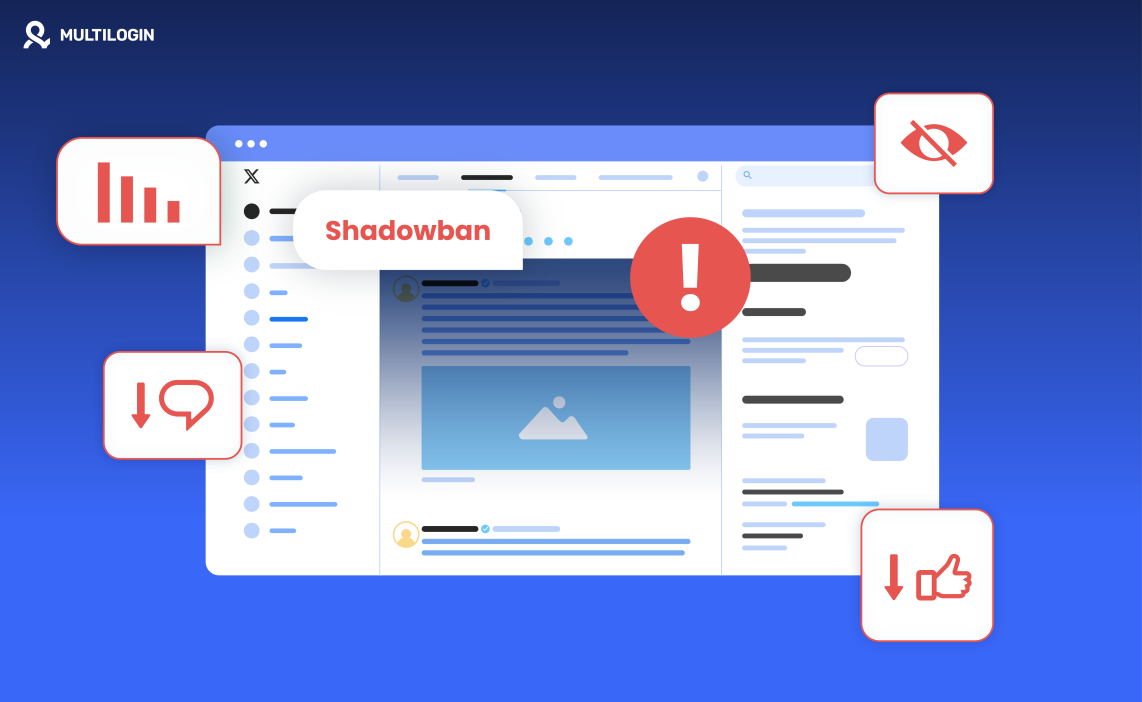Managing multiple Twitter accounts? Try Multilogin’s Twitter Proxy & Antidetect Bundle.
Twitter shadow bans can be a frustrating experience, especially if you rely on the platform to connect with your audience or promote your brand. If you’ve noticed a sudden drop in engagement or if your tweets aren’t getting the visibility they used to, you might be experiencing a shadow ban.
In this guide, we’ll look into what a Twitter shadow ban is, how to identify it, and most importantly, how to avoid or remove it.
What is a Shadow Ban on Twitter?
A shadow ban on Twitter occurs when your account or specific tweets are deliberately hidden or limited by the platform’s algorithm without any direct notification.
Unlike a full ban, you can still tweet, like, and interact with others, but your content won’t appear in search results, hashtags, or on the timelines of users who don’t follow you. Essentially, Twitter reduces your visibility, making it much harder for your content to reach a broader audience.
How Do Shadow Bans Work?
Twitter’s algorithms are designed to detect and limit accounts that exhibit behavior considered spammy, abusive, or in violation of the platform’s rules. When an account is shadowbanned, its tweets may still be visible to the account holder and their followers but won’t be as discoverable by a wider audience.
This means your tweets won’t appear in search results, hashtag feeds, or even in the timelines of users who follow you, unless they specifically visit your profile.
How Long Do Twitter Shadow Bans Last?
The duration of a Twitter shadow ban can vary depending on the severity of the infraction and how quickly you address the underlying issues. Typically, shadow bans last anywhere from a few days to a couple of weeks. If the behavior that triggered the ban continues, the shadow ban could be extended or even result in a permanent ban.
Factors That Influence the Duration
The length of time a shadow ban lasts depends on several factors, including the type of content you posted, how frequently you posted, and whether you’ve violated Twitter’s rules in the past. Accounts that repeatedly engage in behaviors considered problematic may experience longer bans.
How to Get Rid of a Twitter Shadow Ban
If you suspect that you’ve been shadowbanned, there are steps you can take to get rid of the ban and restore your account’s visibility.
Step 1: Review and Remove Problematic Content
Start by reviewing your recent tweets. Look for any content that might violate Twitter’s rules, such as tweets with offensive language, spammy content, or anything that could be perceived as harmful. Deleting these tweets can help reset your account’s status.
Step 2: Reduce Your Posting Frequency
If you’ve been tweeting excessively, take a step back. Limiting your posting frequency can help you avoid looking spammy, which is one of the common triggers for a shadow ban. Giving your account a break for a few days can help reset your status.
Step 3: Engage Genuinely with Your Audience
Focus on interacting with your followers in a natural, genuine way. Avoid using automated responses, excessive liking, or following large numbers of accounts in a short period. Authentic engagement can help restore your account’s credibility.
Step 4: Appeal to Twitter Support
If you believe the shadow ban is unjust, you can reach out to Twitter Support to appeal the restriction. Explain your situation clearly and provide any relevant context that might help in lifting the ban. Keep in mind that getting a response might take some time.
How to Check if Your Account is Shadowbanned on Twitter
Determining whether your account is shadowbanned can be challenging, but there are a few methods you can use to check.
Use a Twitter Shadowban Tester
Several online tools, known as Twitter shadowban testers, allow you to check whether your account or specific tweets are hidden from search results. These tools analyze your account to see if your content appears in searches, hashtags, and on followers’ timelines.
Perform a Manual Check
You can also log out of your Twitter account and search for your content in incognito mode. If your tweets don’t appear in search results or hashtag feeds, it’s a sign that you might be shadowbanned.
Common Reasons for Twitter Shadow Bans
Understanding what causes shadow bans can help you avoid them in the future. Here are some common triggers:
Spammy Activity
Engaging in spammy behavior, such as excessive tweeting, liking, or following, can trigger a shadow ban. Twitter’s algorithms are designed to detect and limit accounts that behave in ways similar to bots or spammers.
Offensive or Inappropriate Content
Tweets that contain hate speech, threats, or other content that violates Twitter’s community guidelines can lead to a shadow ban. Twitter takes a strong stance against abusive content and may reduce the visibility of accounts that engage in such behavior.
Automated Behavior
Using bots or third-party automation tools to increase engagement can flag your account as suspicious. Twitter’s algorithms can detect automated behavior, and accounts that rely heavily on such tools are more likely to be shadowbanned.
How to Prevent Future Shadow Bans
Prevention is the best cure when it comes to shadow bans. Here are some tips to help you avoid future bans:
Follow Twitter’s Guidelines
Adhere to Twitter’s rules and guidelines, especially when it comes to content and interactions. Familiarize yourself with Twitter’s community standards to ensure you’re not inadvertently violating them.
Avoid Automation
Refrain from using bots or automation tools that could be perceived as manipulative. Focus on organic growth and authentic engagement with your audience.
Maintain Consistent Activity
Try to maintain a consistent level of activity on your account. Avoid drastic changes in your posting frequency or engagement levels, as this can raise red flags with Twitter’s algorithms.
Frequently Asked Questions About Twitter Shadow Bans
How do I know if I’m shadowbanned on Twitter?
Signs of a shadow ban include a sudden drop in engagement, reduced visibility of your tweets in search results and hashtags, and limited interaction on your posts.
How long do Twitter shadowbans last?
Shadow bans typically last from a few days to a couple of weeks, depending on the severity of the infraction and how quickly you address the issue.
How do I get rid of a Twitter shadowban?
To lift a shadow ban, review and remove any problematic content, reduce your posting frequency, and engage authentically with your audience. You can also appeal to Twitter Support if you believe the ban is unjust.
Can a shadow ban be removed?
Yes, a shadow ban can be removed. The key is to correct the behavior that triggered the ban and allow time for Twitter’s algorithm to re-evaluate your account.
How do I check if my account is shadowbanned?
You can use online shadowban testers or perform a manual check by searching for your content while logged out or in incognito mode.
How do I stop shadow banning?
To prevent shadow banning, follow Twitter’s guidelines, avoid automation, and maintain consistent activity on your account.
What is a Twitter shadowban tester?
A Twitter shadowban tester is an online tool that checks whether your account or specific tweets are hidden from search results and hashtags.
Can I get unshadowbanned from Twitter?
Yes, you can get unshadowbanned by addressing the behavior that caused the ban and allowing time for the algorithm to reset your account’s status.
How long does a shadow ban last?
The duration of a shadow ban varies but typically lasts from a few days to a couple of weeks.
Curious how to create multiple Google accounts effortlessly? See how Multilogin simplifies the process!
Final Thoughts
Twitter shadow bans can be frustrating, but they are not the end of the road. If you find yourself shadowbanned, follow the steps outlined in this guide to get back on track and prevent future issues.
Remember, the key to avoiding shadow bans is to engage genuinely, follow Twitter’s guidelines, and maintain a consistent, authentic presence on the platform.



